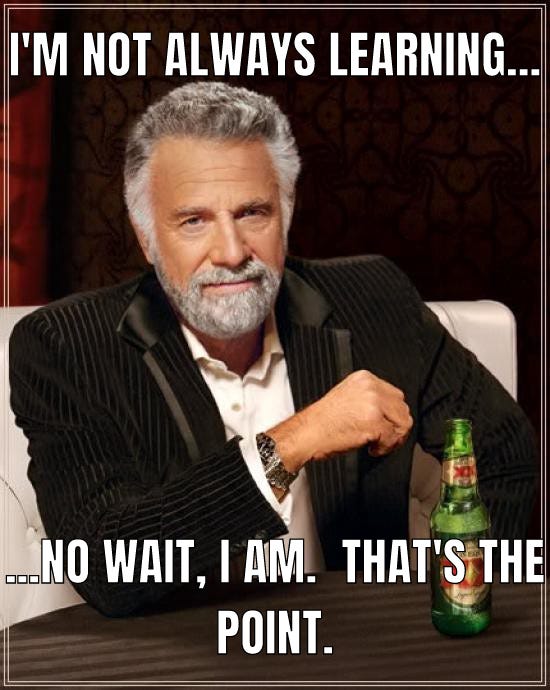🍌 Savannah Bananas & Building Products That Last
My journey of building durable products while still embracing failure
I lead a product that will be celebrating its 24th birthday next year - and the product has more users & higher satisfaction ratings now than at any time in its history. The product and its community of partners and customers have made leaps across several generations of computing and product design. And yet - just like any other product - much of what we tried over the years didn’t work.
Even the most successful products have a meandering path to success and too often the backtracks and failed side quests get glossed over. Some amount of failure is a fact of the product making environment, and planning for and learning from failure is how excellent product teams create durable products that customers can trust.
In the Era of AI, with a lot of viral flash-in-the-pan ideas cropping up, I’ve been spending time thinking about how to create products that will evolve with the times and are “built to last” - and the role failure still plays in getting there.
But first, let’s talk about the Savannah Bananas. Have you heard of them? If not, you are in for a treat. They are an exhibition baseball team for the TikTok era - combining trick catches, dance routines, and a fast-paced play for a fresh take on a day at the ballpark. Go check them out - I’ll wait:
And just in case viral moments aren’t your thing - you can view their journey on product counterpositioning as written up in The Economist.
Learning From Failure
I’ve been looking for material to talk to my team about experimentation, cycle time, and trying new things and this 1-minute gem from one of the founders of the Savannah Bananas is product management gold:
I love when tech truths show up outside tech products - it puts them into stark relief - here’s some excerpts from the video above:
Everything we’ve done for the first time we’ve failed at. We had no idea what we were doing. Most people, when that happens, they give up. We do so much that we aren’t afraid of “so called failure.” If we are not failing, we are not trying big enough things. We have a willingness to get through the messy to get to the great.
Pete Rose has more hits than anyone who has played baseball. He also has 2,000 more at bats than anyone who has played baseball.
Our mindset is to keep coming to bat every single day. Failure doesn’t scare us - it’s part of what we do.
Follow @yellowuxjesse on TikTok. And they are making their way to Seattle in September 2025 - check out their ticket lottery!
Product Making in an Uncertain World
Here are four things I’m incubating to put more of a focus on the uncertain nature of product making:
1. I’m being intentional with my language around failure.
As I talk about this more with my team and stakeholders, I want to choose language that is focused on positive outcomes and strengths that are authentic to our situation. I’ve settled on two phrases: Build resilience and practice curiosity.
Resiliency in product making turns a potential tension into a strength and gives a name to the duality of both transforming ourselves while still executing on the urgent. It can be dialed up in times of momentous change to mean a lot of reinvention or dialed down to focus on sustainable systems. It encourages intentional conversation about context.
Curiosity establishes a mindset of experimentation, calmness, and openness. It reminds the team that product cultures need to collect signal and embrace the unknown.
2. I’m normalizing talking about failure.
As a product leader, I spend most of my time thinking about how to market the most successful parts of the product. I do keynotes on the features and scenarios that survived the Darwinian product fit & scale process. But internally I’m trying to be more circumspect - I know the team needs to hear from me that it’s safe to fail. I will self-admit that like most leaders I am imperfect at this, but I have three tools that I’ve seen that I like:
“Share Your Fail.” Twice a year our team has Hack/Hack/Learn weeks and one of the scheduled sessions is a space for people to share stories of failure. 5–10 minute lightning rounds where people sign up to talk about things that didn’t go as they planned.
I’m not sweeping history under the rug. Recently, I presented at a leadership onsite a list of projects we’ve cancelled, products we’ve deprecated, and systems we’ve had to replace in the product over the past ten years. It was a busy PowerPoint slide - 3 columns and over 30 items on it! This reinforces that projects and products failing is a fact of life that must be planned for.
I spend pre-coding time naming our risks. My biggest takeaway from Marty Cagan’s Inspired: Instead of a pre-code specing process focused on only driving alignment, instead I use pre-code time in a product discovery process focused on identifying and reducing risks of failure. Our PM doc templates embed this in - requiring people to identify and rank the types of product risk (e.g. design, business, value, et cetera) and create a plan to minimize. The risk is there - I’m trying to get the team to remember to name it.
3. I’m institutionalizing learning on the job.
Over the years, the leadership sponsorship role I’ve had the most fun with is sponsoring our Learning & Development programs. I’ve thought deeply about how to embed learning while on the job. This is why to me habits, mindsets, and bets around learning-while-doing are more important than structured coursework. I talk about this in detail here:
4. I’m stepping in to make sure the team takes some low percentage shots.
Tell me if you’ve been here: I’ve got a backlog that is so overflowing that I must make tough tradeoffs around extremely urgent and important items. Every item I’ve prioritized for the next sprint - and the first ten I can’t yet prioritize - has a high percentage chance of delivering value that customers have explicitly asked for.
I hear this story from busy GPMs all the time. It’s impossible for backlog owners on their own to make room for anything except the urgent. But what about the unarticulated need? That’s much more risky - and I’ve found that it requires an interruption from senior leadership - an explicit requirement to focus and fund some high risk/high return speculative investments - to break the logjam. Examples from my work life over the years are often tied to emerging tech - mixed reality, AI, new social media trends. I’m sponsoring tools like Design Sprints - focused on non-urgent ideas with lots of upside - to give product teams a chance to dream.

Wrapping Up
If this post were about startup culture, it would have been easier to write - worship disruption, experiment without emotional attachment, and embrace long-shot odds. And hey, if it fails, someone else in the VC’s portfolio will succeed.
But my needs are to talk about failure and pushing the envelope as part of an existing product in a large company. It’s much more nuanced with a lot more riding on the outcome: existing customers are betting on my product to evolve with them. But at the end of the day, it gives me deep purpose to be part of that journey with them.
Oh, and here’s one more Savannah Banana video to brighten your day:
The fact that the umpire dances too is 💯.







